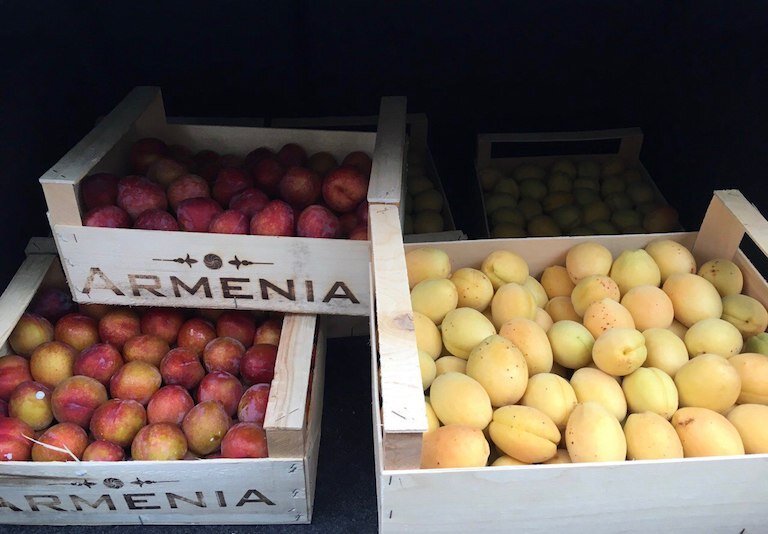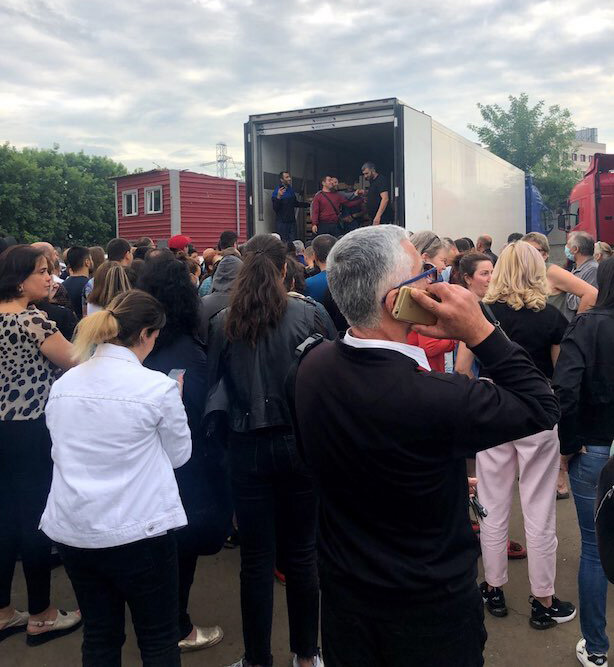By Liana Aghajanian
This week saw the heaviest fighting along the Armenia-Azerbaijan border in years, with at least 16 killed on both sides, the destruction of structures along border villages, and the downing of drones.
What followed included efforts to de-escalate tensions, statements from various diplomats like U.S. Secretary of State Mike Pompeo who said the U.S. was “deeply concerned,” protests in Baku calling for war, cyber attacks, and various threats to continue the fighting.
But in Russia – where the largest diasporas of both Armenians and Azerbaijanis live, another kind of proxy conflict was boiling over.
The weapon of choice? Apricots.
The fruit fight began when Azerbaijanis bought pallets of perfectly luscious apricots – Armenia’s largest export and treasured national symbol – and filmed themselves destroying the crops by stomping on them – videos of which were shared across social media networks including TikTok and Twitter.
Next, Armenian apricot exporters found themselves in an unexpected jam.
An estimated 50 drivers from Armenia, who had arrived in Moscow carrying tons of ripe apricots, were refused entry by market managers to sell their product at Food City, a large wholesale market in Moscow. One third of the fresh food products found in the capital are sold through the outlet everyday, according to Eurofresh Distribution magazine.
It was unclear where the explicit order to block the trucks and specifically target and prohibit Armenian sellers from entering came from or why (local press have not been able to reach or receive a statement from the owners), but social media users speculated that it was a decision made by the market’s owners, God Nisanov and Zarakh Illiev, wealthy businessmen dubbed the “Russian Real Estate Kings” by Forbes and owners of the conglomerate Kiyevskaya Ploshchad, which the Food City complex falls under.
Both Nisanov and Illiev are natives of Azerbaijan, belonging to the country’s minority Jewish community often known as “Mountain Jews.”
One apricot exporter named Lernik Avagyan told Armenian-language paper Aravot Daily, that an Azerbaijani friend told him that outsiders had frightened locals from purchasing Armenian goods.
“He always used to buy produce from me, but he said that he can’t anymore because he is scared,” Avagyan said.
Various representatives, including those from the Armenian Embassy in Moscow, arrived and attempted to diffuse the situation to no avail. The Armenian ambassador in Russia Vardan Toganyan, told the Russian news agency, RBC, that embassy employees were forcibly escorted by security guards of the market and the cars remained blocked.
Beyond the obvious economic impact – the sheer idea of tons of apricots going to waste was one that didn’t stick well with the Armenian psyche. The apricot, whose scientific name“Prunus Armeniaca,” pointing to its Armenian connection, is a treasured symbol to Armenians worldwide. The orange on the tricolor Armenian flag is often referred to as the “color of an apricot,” and the duduk, an ancient wind instrument said to be indigenous to the country, is made of apricot wood. The annual film festival of Armenia is called the Golden Apricot, and in 2010, Armenia’s entry into the Eurovision song contest was a pop-infused ballad by Eva Rivas called “Apricot Stone,” in which she calls apricots “kisses of the earth, fruits of the sun.”
I’ve even written about the allure of the Armenian apricot, a taste so sweet and rich that it’s impossible to come across apricots that measure up almost anywhere else.
As the Armenian apricot embargo remained in place in Moscow, the fragile fruits were running out of time, and a mass preservation effort began.


The news about the fruity melee had spread far and wide on social media networks among the Armenian community in Russia, who quickly mobilized in an effort to support their fellow countrymen, now saddled with hundreds of thousands of dollars worth of perishable fruit.
The Ministry of the Economy of the Republic of Armenia worked to come up with a plan, coordinating to get four alternative locations where sales could take place, one of which was organized by the Tashir group, owned by Armenian businessman Samvel Karapetyan. Other points of sales were also opened by Armenian entrepreneurs who owned shopping centers.
“When we realized there was no way to get our people inside, that’s when we interfered and negotiated with some trade centers, to start selling Armenian fruit,” Anna Ohanyan, the spokesperson of the Ministry of Economy in Armenia told me in a call. “But as apricots cannot stay fresh for long, other Armenian compatriots came to help, and so they started buying the apricots.”
A Telegram channel called “Operation Apricot” was launched, which now has over 1,000 members. Several appeals went out to Armenian residents in Moscow to come buy the apricots. One of the main organizers, David Tonoyan, also coordinated apricot donations to hospitals and orphanages in Moscow.
Soon pallets of apricots were now being sold off the back of trucks directly to members of the Armenian community. The crowds continued to grow and the wait to buy products ballooned to around 2 hours.
The fruit blockade had turned into a full blown Armenian apricot festival.


Free food, including shish kebabs and lavash sandwiches were distributed, musicians showed up, dancing began and the age old tradition of never ending after dinner speeches expressing solidarity and support also commenced. Facebook user Edgar Hambarzdumyan live streamed over 3 hours of the event through his page, filming never ending lines, a full parking lot of stalled cars, and apricot aficionados carrying several pounds of fruit away.
Anna Mazmanyan, who lives in Moscow, was one of Armenian community members who showed up to buy apricots.
“I personally believe that when something happens to an Armenian in any part of the world, if I can, I must react. Especially in the situation where it can cause direct damage to the interests of the Republic of Armenia,” she told me on Facebook.
Mazmanyan, who is the founder of the annual Yerevan Food Fest and the gastronomic project, Gastronomic Camp Armenia, bought 50 kg (equivalent to 110 lbs). She plans to give apricots away to relatives, make jam for the winter as well as sorbet and pie.
Some expressed uneasiness about attempts to undermine sales and limit business based on ethnicity in another country altogether.
“As Russian citizen I am deeply concerned that somebody thinks and feels that he can violate the law of my country and as a tax payer in Russia I do not see clear reaction of the local authorities, and I see that my rights are jeopardized,” she said.
Despite the ongoing serious tensions between Armenia and Azerbaijan because of the Nagorno-Karabakh conflict, relations between the two minority communities in Russia are generally stable, which is why the apricot blockade took many by surprise.
“No one expected this to happen, said Luana Saratikyan, who was involved with organizing efforts along with Tonoyan..
“I think that is an absolutely low act to transfer the conflict to the territory of a third country,” she told me, adding that actions of the Food City management were inciting ethnic hatred. “We condemn this act on the part of our neighbors and call for resolving all issues exclusively through peaceful negotiations.”
Over 16,000 tons of Armenian apricots have already been exported this month according to Ohanyan, with the majority of exports going to Russia. Grown in Armenia’s fertile Ararat Valley, surges in Armenian apricot exports began in 2010 when the Upper Lars border crossing between Georgia and Russia reopened. The fruit, too perishable to be exported overseas, can be found in dry form and jams abroad, including in the U.S. Azerbaijan exports apricots too, with Russia being the top receiving destination for Azerbaijani fruit.
Buying apricots from Armenia/ Image by Tamar Manoukyan/ Instagram
Buying apricots from Armenia/ Image by Tamar Manoukyan/ Instagram
As more truck loads of Armenian apricots arrive in Moscow, the new points of sale will run as logistics are figured out if the situation continues.
“This was a really good marketing campaign for us,” Ohanyan said. “Such kinds of provocations don’t prove successful for them, they just prove the opposite.”
Dining in Diaspora is a project documenting the complex legacy of Armenian food in the diaspora. Follow on Instagram and Facebook










